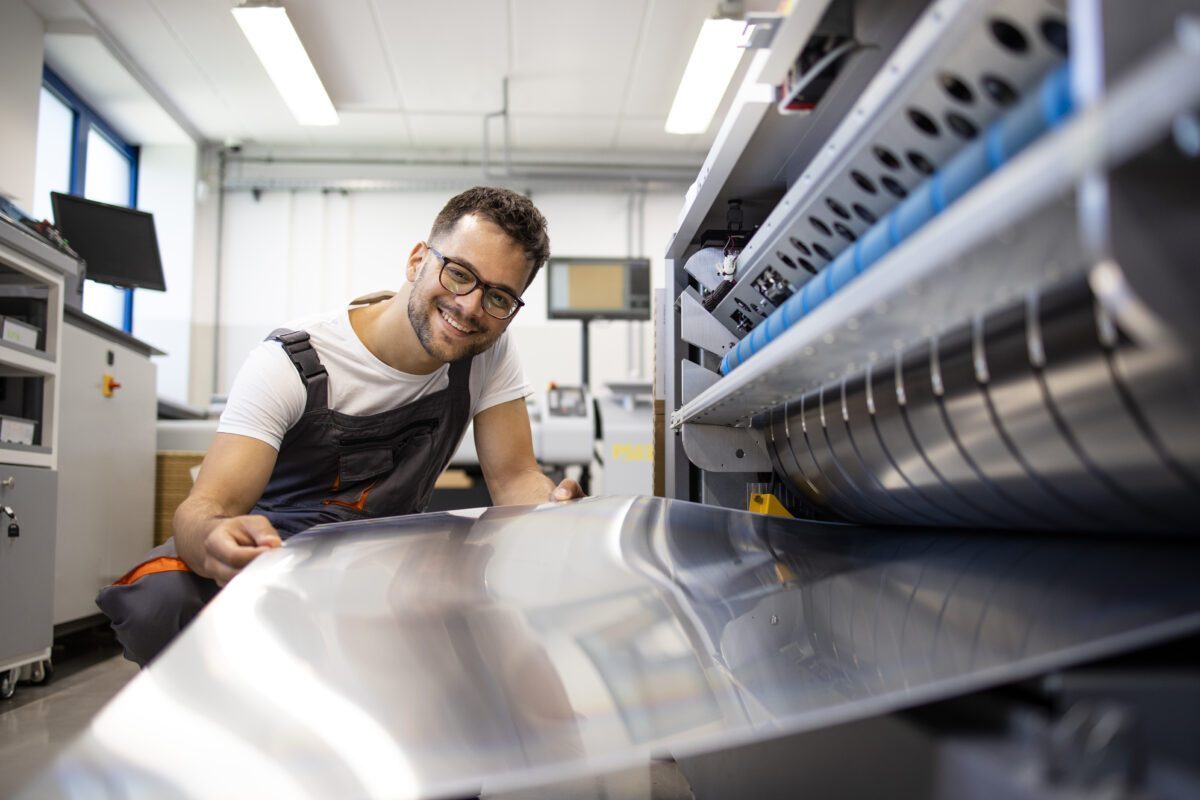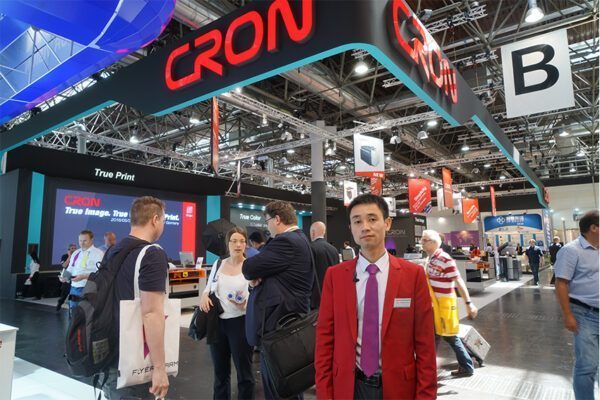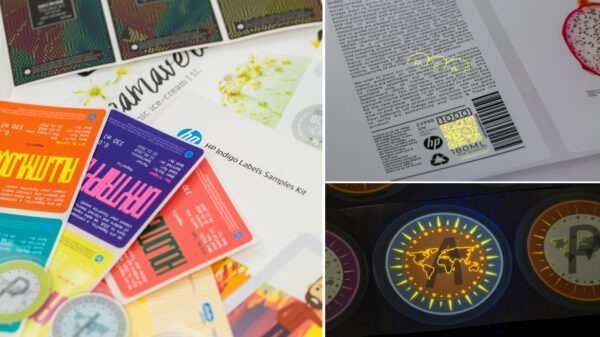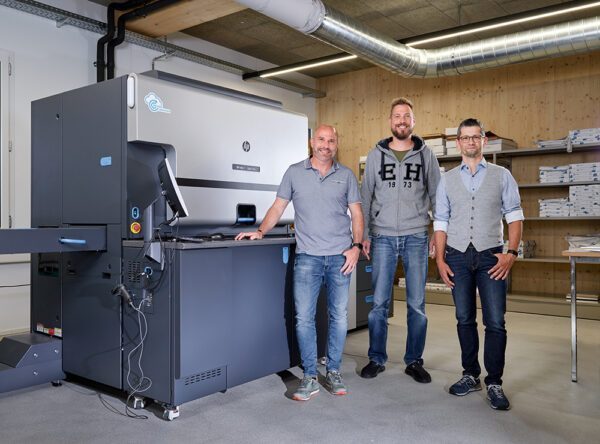Around half of Swiss offset printers are already using processless printing plates. For the other half, now is a good time to make the switch: on the one hand, saving energy and resources is the order of the day and, on the other, a new generation of plates makes this process even more attractive and reliable in terms of price.
Plate production using a computer-to-plate system (CtP) is the central key point in the workflow of an offset print shop: this is where the virtual prepress world of bits and bytes manifests itself for the first time in something tangible, namely the printing plate. A laser controlled by the digital data images it in the CtP platesetter. Before this can be used for printing, a further step is required: the print image must be exposed. Similar to the earlier workflow with films, this was always a chemical process in the early days of CtP technology: the print image written by the laser is developed. This means that the printing plate runs through a developing machine in which the printed image is "developed" by chemically washing out the non-printing layer.
The first processless printing plates came onto the market around 15 years ago as a successor technology to this chemical process. These plates go from the CtP system directly into the printing press. Only here is the print image exposed, as the dampening solution dissolves the non-printing areas of the printing plate. These dissolved areas are then detached by the tack of the ink and completely removed from the press with the help of the first waste sheets. A sophisticated process that enables a streamlined workflow with many advantages. So it's no wonder that around half of offset printing plants in Switzerland today operate without a process.
Sophisticated technology in the third generation
For the other half, now is a good time to make the switch. The technology is mature and most plate manufacturers are already on the market with the second or, in the case of Fujifilm, even the third generation (see box). Teething troubles have long since been eradicated and costs within production can only be reduced in the short and long term by using processless printing plates. This advantage was quickly recognized by the innovative Internet printers in particular, who consistently exploit the savings potential offered by the use of processless printing plates and produce highly automated printing plates - with low production costs and personnel costs. The largest of these have a consumption of over one million square meters of processless printing plates per year. This is also an indication that the technology for the future of printing plates is now mature and absolutely reliable - and above all: profitable!
Eliminate a major cost factor with the development machine
If you already have a thermal imagesetter, you can make the switch to a processless future without having to invest in new hardware. On the contrary: with the processor, a high-maintenance and cost-intensive piece of hardware can be phased out! After all, this is precisely the most compelling argument for a changeover: the development machine eliminates a major - and often underestimated and uncalculated - cost factor. An honest analysis reveals a whole catalog of direct and indirect costs of the chemical process with the development machine:
- Personnel costs for internal service: constantly monitor and change chemicals, clean machine regularly, etc.
- External maintenance: repairs and replacement of wearing parts
- Chemistry as a consumable
- Disposal costs
- Consumption of electricity and water
- Downtime in panel production during maintenance and cleaning of the processor
- Space costs for the developing machine
- Amortization and/or leasing of the machine
In addition to this great savings potential - not least due to the reduction in the drastically increasing costs for the disposal of chemicals in the future - the processless workflow also offers qualitative advantages. By eliminating the developing machine, which by nature is the biggest factor influencing the quality of a printing plate, a much more stable and reproducible production can be guaranteed. Missing plates are drastically reduced, resulting in less press downtime. With these advantages, it seems only logical that the future of printing plates is clearly processless.
Take a considered and structured approach to the changeover
The fact that not all companies have yet gone processless despite these sustainable arguments is probably also due to respect for the changeover to a functioning workflow. In fact, it is worth taking a well-considered and well-structured approach to the start of a process-free future.
In the course of its many years of experience as a provider of processless plates, Chromos has developed a seven-step procedure that leads reliably from evaluation to implementation. The Chromos specialists are in charge of the changeover and also coordinate the steps and interfaces with the workflow solution providers and printing presses involved.
How to make the switch
- Estimate the savings potential by "scrapping" the developing machine with the associated costs for maintenance, water, chemicals, etc. The changeover is usually also worthwhile if an older UV platesetter has to be replaced by a thermal platesetter.
- Visit to an offset print shop with a similar setup that has already switched to processless. Exchange of experience from team to team - both prepress and printing.
- Test in your own company with processless plates that have been imaged by a print shop that has already been converted - ideally by the one in step 2.
- Definitive, broadly supported decision within the team to switch to a processless workflow; if necessary, investment in a thermal imagesetter.
- Conversion of the workflow solution in prepress: if necessary, change the print image from positive to negative. In cooperation with the workflow provider.
- Calibration of the platesetter: linearize to new plates and then calibrate. In cooperation with the workflow provider.
- Fine adjustments to the printing presses for perfect plate run-out.
Also the FO phototar: process-free in seven steps

One example of such a step-by-step conversion is FO-Fotorotar in Egg. The great savings potential of a changeover was quickly recognized here too. To get a concrete picture of how this works in practice, the FO team visited the Mattenbach print shop in Winterthur. It has a very similar set-up with its machinery. Direct personal contact showed that the process-free workflow works to the complete satisfaction of everyone involved in prepress and on the press.
The next step was to have a set of plates produced at Mattenbach, which were then sent to the printing press in Egg without any fuss. Everything worked perfectly and the last reservations about problems with the fountain solution were finally put to rest. FO-Fotorotar was therefore able to give the green light for the changeover. This went off without a hitch under the supervision of Chromos.
So kann Vorstufenleiter Stefan Balmer eine durchwegs positive Bilanz ziehen: «Das Einrichten des prozesslosen Workflows war für uns die Gelegenheit, Prozesse zu hinterfragen und neu zu definieren. Im Rahmen der Umstellung haben wir Plattenzettel eingeführt und auch damit die Prozesssicherheit nochmals erhöht. Die Zuständigkeiten sind jetzt absolut klar: Alles für den Drucker Relevante steht jetzt auf dem Plattenzettel und es gibt keine optische Kontrolle der Druckplatte mehr. Die Endkontrolle passierte schon im PDF (als Gut zum Druck) und der Drucker darf <blind> darauf vertrauen und mit den Platten direkt vom Belichter in die Maschine gehen. Dies hat auch den Vorteil, dass er notfalls in einer Nachtschicht selbst eine Platte belichten kann.». Neben diesen Optimierungen des Workflows hebt Stefan Balmer auch den ökologischen Aspekt hervor: Rund zehn Liter Frischwasser wurden früher pro Druckplatte verbraucht. Dazu kam noch die Chemie und der Stromverbrauch. Und dass sich das Ausschalten dieser «Ressourcen-Verschwendung» auch ökonomisch positiv auswirkt, versteht sich von selbst.
How processless printing plates work
The process-free printing plates are coated with special polymers. These are thermally exposed in the CtP system, i.e. using an infrared laser. Where the laser writes the print image, the polymer particles fuse with each other and with the aluminum plate. In the printing press, the unexposed areas of the layer swell due to the pre-wetting, are detached from the aluminum plate by the "speed" of the printing ink and land with the printing ink on the waste sheets. After just 10-20 sheets, the plate has been released in this way and the print run can begin.
Stubborn prejudices are debunked
Since the introduction of processless printing plates, the industry has been rife with misconceptions, which will be refuted here. The first is that the detached polymer layer contaminates the fountain solution. As explained above, this is not the case. The dissolved polymers go onto the waste paper with the printing ink. The second prejudice assumes that the ink rollers are stressed by the polymer particles in the ink and suffer. This statement is not valid either. Compared to the stress on the rollers caused by the paper dust, the minimal coating residue in the form of polymer particles is negligible.
Due to the rising prices for energy and resources within production now and in the future, but also the increasing pressure from society to produce print products in a more ecological and sustainable way, more and more companies within the graphic arts industry are looking for alternative solutions. Why produce a printing plate today with expensive processors, water, chemicals, disposal costs and high personnel costs when there are already alternatives?
For this reason, manufacturers such as Fujifilm have been working for years to develop printing plates that can be processed without any of the points described above and also make their contribution to greater ecology and sustainability. Fujifilm's goal is to produce 80% of its printing plates as processless in the next few years in order to achieve its internal climate-neutral goals of saving 90 million tons of CO2 worldwide within production by 2030. Fujifilm was thus a pioneer in processless printing plates and today has more than 15 years of experience in this field.
This article was published in September 2023 in the trade journal swiss print+communication
Fujifilm Superia ZX

The Superia ZX is the third generation of plates to replace today's popular Superia ZD and is characterized by the following additional advantages:
- Thanks to "Extreme Adhesive Bonding Technology", even longer print runs are possible - with reliably high print quality right down to the last copy.
- The visibility of the print image on the plate has been significantly improved compared to the ZD series.
- A new coating formula prevents paint stains caused by scratches. This makes handling the panels even easier.
Contact us
Do you also want to switch to process-free panel production? Our experts will be happy to help you. Get in touch with us.



